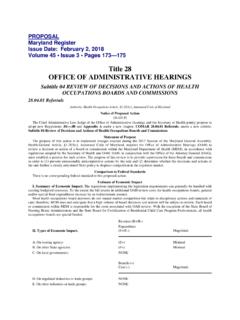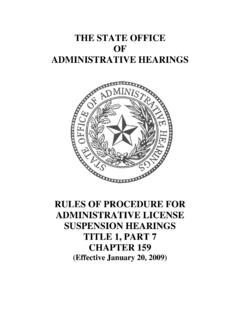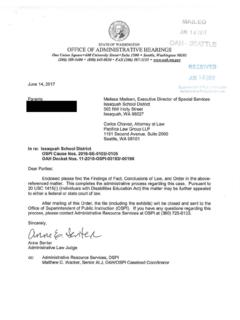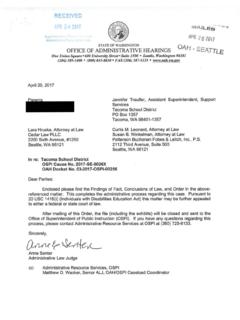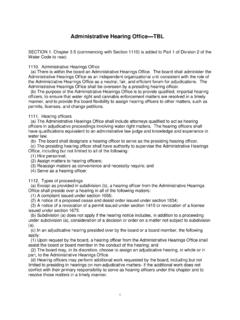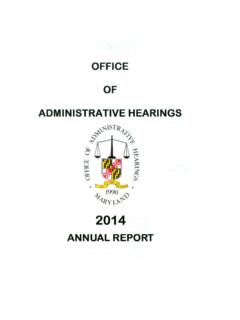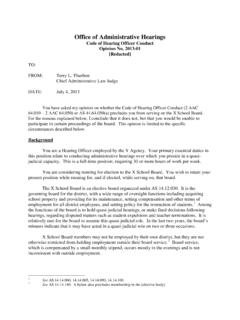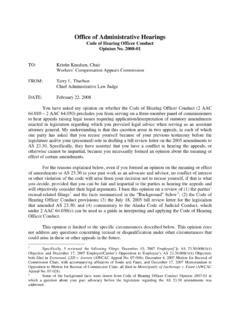Transcription of Administrative Hearings Office - Minnesota Legislature
1 Administrative Hearings Office Background: Office of Administrative Hearings MN LCPR (rev. 10/2012) p. 1 Background Information on Office of Administrative Hearings11. EstablishmentThe Minnesota Office of Administrative Hearings was established formally on July 1, 1975, but was not permitted to conduct Administrative law Hearings until January 1, 1976. During that initial six months of the agency, a chief hearing examiner was appointed, a staff was hired, facilities were rented, and equipment and Office supplies were acquired from the agency s initial, nonrecurring appropriation of $167,000. Subsequently, the operating costs of the Office of Administrative Hearings would be borne by the governmental entities which referred Hearings to the agency, based on hourly charges to be deposited in a revolving fund account.
2 The Office of Administrative Hearings , initially named the Office of hearing Examiners, was created in 1975 (Laws 1975, Ch. 380, Sec. 16-18) as part of broader Administrative procedures legislation. Minnesota was the second state to create a central Administrative hearing Office , following California. The Office is an independent state agency in the Executive Branch. Initially, the Office of Administrative Hearings was organized into three units, which were a utilities regulation and transportation unit, an environmental unit, and a general regulatory unit. Over time, with cross-assignments of the limited number of hearing officers, unit specialization disappeared in the late 1990s. In 1981 (Laws 1981, Ch.)
3 346, Sec. 2), the Office of Administrative Hearings was expanded by an extension of its jurisdiction to workers compensation appeals, with the creation of the positions of compensation judges and the transfer of all workers compensation hearing functions from the Department of Labor and Industry, but the case docket governed by Minnesota Statutes, Chapter 176. In 1987, on a pilot project basis, the Office of Administrative Hearings undertook an expedited Administrative process for enforcing child support obligations, which became the Child Support Unit in 1992, serving 39 Minnesota counties. By 1994, the child support enforcement program was expanded to all 87 counties. In 1999, the Minnesota Supreme Court, in Holmberg v.
4 Holmberg, 588 NW2d 720 (1999), held that the Office of Administrative Hearings child support hearing process was an unconstitutional delegation of judicial power to an Executive Branch agency. In 2001, the child support hearing function was transferred back to the state court system. In 1998 (Laws 1998, Ch. 366, Sec. 80-82), the workers compensation settlement function that was retained by the Department of Labor and Industry in 1981 was transferred to a Workers Compensation Settlement Division established in the Office of Administrative Hearings . In 2010, the Workers Compensation Settlement Division and the Workers Compensation hearing Division were combined into a single division. In 2004 (Laws 2004, Ch.)
5 277, Sec. 7-11), civil remedies were created for potential campaign violations and the Office of Administrative Hearings was substituted for the various county attorneys as a mechanism for a faster resolution of alleged violations of the Minnesota fair campaign practices and financial reporting requirements. The Office of Administrative Hearings disposes of fair campaign practices administratively prior to any criminal prosecution by the applicable county attorney. The number of campaign-related complaints declined after the change. In 2005, the municipal boundary adjustments Office was transferred to the Office of Administrative Hearings by Reorganization Order 192. In 2008 (Laws 2008, Ch. 196, Art. 1), the transfer of the municipal boundaries adjustment function from the Office of Strategic and Long Range Planning to the Office of Administrative Hearings was reflected in corrections to the boundary adjustment law.
6 2. Purpose. Before July 1, 1976, Administrative contracted case Hearings were conducted by agency employees. After taking testimony and assembling evidence, those employees would make recommendations to the heads of their agencies about what to do. Many commentators and affected parties felt that it was unfair to have agency employees conduct those Hearings . The Office of Administrative Hearings was created to provide an impartial hearing process for individuals who disagree with actions taken by the government. The addition of workers compensation adjudication function occurred because of concerns about the neutrality and independence of the prior compensation judges. While hearing examiners were required to have demonstrated knowledge of Administrative procedures and to be free of political or economic associations that threaten fairness and objectivity, compensation judges were required to be lawyers, to have a demonstrated knowledge of workers compensation laws and be free of political or economic associations that threaten fairness and objectivity.
7 The Workers Compensation Division judges salary structure, set as a percentage of state district court judges, differed from the hearing examiner salary structure, forming an impediment to internal cohesion. Administrative Hearings Office Background: Office of Administrative Hearings MN LCPR (rev. 10/2012) p. 2 3. Function1.. The Office hears and decides cases in four main areas: Administrative Procedures Act State Agency Contested Cases and Rulemaking Hearings Budget: Nearly all of the Administrative Law Program operates as an Enterprise Fund. Each year Minnesota Management & Budget sets billing rates for the services rendered to client agencies.. Judges in the Administrative Law Division provide hearing and mediation services to more than 100 state agencies and local units of governments.
8 Administrative Law Judges preside in Hearings on a broad array of matters relating to rulemaking, state licensing, utility regulation, fair campaign practices, data practices and the operation of government programs. Ten judges are assigned to the Division. 2. Local Government Licensing and Personnel Cases3.. Workers Compensation Benefit Hearings Budget: The Workers Compensation Program is funded from the Special Compensation Fund through a biennial appropriation of $ million. No General Funds are used.. Judges in the Workers Compensation Division conduct pretrial and trial level functions associated with claims for workers compensation benefits. Those functions include ruling on motions, conducting settlement and pretrial conferences, mediations and trials, and issuing awards and final decisions.
9 The Office of Administrative Hearings conducts Hearings in locations across Minnesota -most often in one of six Hub Cities : Duluth, Walker, Alexandria, Mankato, Rochester and St. Paul. Twenty-two judges are assigned to the division. 4. Adjudication of Municipal Boundary Changes Budget: The MBA is funded through an annual appropriation from the general fund of $267,000.. The Municipal Boundary Adjustments unit (MBA) of the Office of Administrative Hearings administers and adjudicates the uniform system of municipal boundary adjustments codified in Minnesota Statutes, Section 414. Legal orders are issued for the creation or dissolution of municipal boundaries through incorporation, consolidation, annexation or detachment of land.
10 MBA staff review and facilitate approximately 250 petitions for boundary adjustments annually. The majority of petitions are from property owners; the rest are from cities and townships. All adjustments affect local government, as well as property owners, and have the potential for conflict or agreement. Consultation and technical assistance on issues relating to municipal boundary adjustments is available. Four staff, a n assistant chief j udge, a c ourt e xecut ive , a nd two state progr am a dmini strator s, are assigned to the unit. 4. Chief hearing Examiner The initial chief hearing officer, appointed on July 25, 1975, and serving until June 30, 1988, was Duane R. Harves.. Office of Administrative Hearings chief judge is appointed to six-year term(s) by the Governor.

